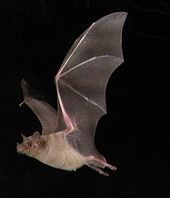Fontein Grot
Coordinates: 12 ° 29'37.3 " N , 69 ° 54'22.2" W.
Location of Fontein Grot in Aruba |
The Fontein Grot ( German : Brunnengrotte) is a small natural karst cave in today's Arikok National Park near Boca Prins on the east coast of the island of Aruba . The access is around 20 meters above sea level . The grotto has a floor area of around 1700 square meters.
description
The grotto is known for its cave paintings on the cave ceiling and walls, which were carved into the limestone by local members of the Arawak, an indigenous people . The pre-Columbian drawings consist mainly of multicolored geometric motifs and symbolic images. The drawings were discovered in 1836. In 1890 Alphonse Pinart (1852–1911) published detailed information on the Indian rock carvings.
The drawings are accessible via a steep slope and a terrace made of coral limestone. The grotto at this point is three meters wide and two meters high. The entrance hall, which is open to visitors, is four meters high and extends to a depth of 50 meters. The geological formation of limestone allows seepage water through, which gave rise to stalagmite and stalactite formations in various bizarre shapes and sizes.
The grotto is inhabited by long-nosed bats ( Leptonycteris curasoae ), hundreds of which live in small niches. The bats use the grotto as a resting and breeding place. You'll leave the cave in the early evening, then look for nectar and pollen from the island's divi-divi trees and cacti. In addition, the species contributes significantly to the spread of cactus seeds. They are an important part of the local ecosystem and are subject to special species protection.
There is also a small freshwater spring in the grotto area. The temperature in the grotto is around 30 ° C. There is a relatively high humidity averaging 85 percent. The Fontein Grot is the most visited cave on the island.
Web links
- Grottoes in Aruba from nl.aruba.com, accessed December 23, 2014
Individual evidence
- ↑ Soriano, P. & Molinari, J. (2008): Leptonycteris curasoae. The IUCN Red List of Threatened Species. Retrieved October 30, 2018.



